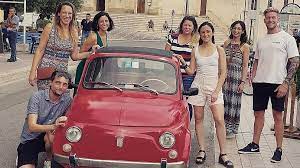Italy: How we transformed a tiny rural village into first digital nomad community

Tursi: When we stumbled on the rural village of Tursi in January 2022, we knew we’d hit the jackpot.
With a coworking space inside a converted 16th-century monastery, this Italian idyll was the perfect place to kick off our start-up.
Our vision? To bring digital nomad communities to our country’s undiscovered gems.
Tursi’s unique coworking space is the work of local association Tursi Digital Nomads. It is located in Basilicata, a beautiful south Italian region still relatively unknown to both Italians and foreigners.
We make our first visit on a cold winter’s day. The building is empty but we can vividly imagine our community working from these beautiful rooms and sharing coffee breaks on the terrace overlooking the green valley below.

As we bid farewell to the association’s president, Salvatore Gulfo, we’re not exactly sure what will come next, but we know we’re onto something.
Tursi, Basilicata, is a beautiful south Italian village relatively unknown to touristsSerna Chironna and Andrea Mammoliti
Tursi ticks a lot of boxes for our digital nomad village. It is a charming old borgo huddled in a scenic rural setting. It is off the beaten track, meaning fewer tourists and more authenticity. And, of course, there’s a beautiful coworking space ready to go, provided by the local municipality.
Luckily, local enthusiasm for the project is high. Tursi’s residents believe remote workers can breathe life into the village’s sleepy old town. So we partner with Tursi Digital Nomads and start planning.
Despite having many of the right ingredients for our project, Tursi is by no means perfect. One major challenge stands out.
Ask any digital nomad what they look for first in a destination, and they will reply without hesitation: “reliable internet.” Not only reliable but fast and readily available. Although we have an old town full of houses to repopulate, most of them lack a stable internet connection.
After countless hours of planning meetings, calls with internet providers and conversations with landlords, we manage to secure enough houses and equip them with internet.
We are finally ready to host our community of digital nomads – or ready enough, at least.
Our first Tursi nomad arrived in early June. Over the following six weeks the community grew, bringing diversity to the small town.
In total, we hosted 19 digital nomads from 13 countries: Argentina, Belgium, Bulgaria, Greece, Hungary, Italy, the Netherlands, Peru, Poland, Portugal, Romania, the UK and the USA.
Fears our community might get bored in such a tiny place were soon abated. Every week, we put on a full roster of events and activities – fitness sessions in the local park, house dinners, coffee and happy hours in the main square (lots of them), weekend trips to explore Basilicata and much more.
At the end of the pilot, we asked our community what they enjoyed the most about the experience. The verdict was unanimous: the authenticity of the village and the friendly local community.
After the success of our debut project, we left with five key takeaways for setting up a digital nomad community.
Many digital nomads want to be surrounded by an international community, but they also appreciate an authentic experience. Facilitating connections with the locals and their culture is key.
Building strong relationships with residents and local businesses – both before and during our project – was integral to our success. Not only did our friends from Tursi help us with groceries, introduce us to the best of Basilicata, and give us tips on where to (and where not to) eat, they supported our project because we took their needs into account.
Establishing a long-term digital nomad community in a remote village with infrastructure challenges requires careful planning, long-term thinking and close collaboration with private actors and local administration.
Building digital nomad communities in remote places is tough and not everything will be perfect from day one. We learned to be OK with that.
In the end, what made our project a success is community and people. Get that part right and you will be halfway to success!





